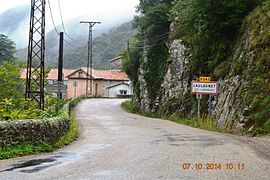Asperjoc
Asperjoc | |
|---|---|
 The entry to Laulagnet | |
| Coordinates: 44°41′09″N 4°21′35″E / 44.6858°N 4.3597°E | |
| Country | France |
| Region | Auvergne-Rhône-Alpes |
| Department | Ardèche |
| Arrondissement | Largentière |
| Canton | Aubenas-1 |
| Intercommunality | Pays d'Aubenas-Vals |
| Government | |
| • Mayor (2008–2020) | Alain Chiraussel |
Area 1 | 8.47 km2 (3.27 sq mi) |
| Population (2010) | 393 |
| • Density | 46/km2 (120/sq mi) |
| Time zone | UTC+01:00 (CET) |
| • Summer (DST) | UTC+02:00 (CEST) |
| INSEE/Postal code | 07016 /07600 |
| Elevation | 278–879 m (912–2,884 ft) (avg. 299 m or 981 ft) |
| 1 French Land Register data, which excludes lakes, ponds, glaciers > 1 km2 (0.386 sq mi or 247 acres) and river estuaries. | |
Asperjoc is a commune in the Ardèche department in the Auvergne-Rhône-Alpes region of southern France.
The inhabitants of the commune are known as Asperjocois.[1]
Geography
Asperjoc is located some 2 km north by north-west of Aubenas and 18 km west by south-west of Privas. Access to the commune is by the D 578 road from Antraigues-sur-Volane in the north which passes down the eastern border of the commune and continues south to Vals-les-Bains. The D 243 branches off the D 578 in the south of the commune and goes north-west through the commune and continues to Labastide-sur-Bésorgues. The commune has no village called Asperjoc but has several hamlets: les Beaumelles, la Brugeyre, le Chastelas, le Fau, Laulagnet, le Pont de Bridou, le Pont de l-Huile, la Praye, le Raccourci, le Rigaudel, Thieure, Tras Chabanne et la Valette inférieure. The commune is rugged and alpine in nature with little or no arable land.[2]
The Volane river forms the entire eastern border of the commune as it flows south to join the Ardèche south of Vals-les-Bains. The Besorgues flows from the north-west of the commune south-east forming part of the western border of the commune and gathering many tributaries in the commune before joining the Volane at the southern corner.[2]
Neighbouring communes and villages[2]
Administration

List of Successive Mayors[3]
| From | To | Name | Party | Position |
|---|---|---|---|---|
| 2001 | 2008 | Louis Berthon | ||
| 2008 | 2020 | Alain Chiraussel |
(Not all data is known)
Demography
In 2010 the commune had 393 inhabitants. The evolution of the number of inhabitants is known from the population censuses conducted in the commune since 1793. From the 21st century, a census of communes with fewer than 10,000 inhabitants is held every five years, unlike larger towns that have a sample survey every year.[Note 1]
Template:Table Population Town



Distribution of Age Groups


The population of the town is relatively old. The ratio of persons above the age of 60 years (22.3%) is higher than the national average (21.6%) but lower than the departmental average (28.1%). As for national and departmental allocations, the male population of the town is less than the female population (48.8% against 48.4% nationally and 48.2% at the departmental level).
Percentage Distribution of Age Groups in Asperjoc and Ardèche Department in 2010
| Asperjoc | Asperjoc | Ardèche | Ardèche | |
|---|---|---|---|---|
| Age Range | Men | Women | Men | Women |
| 0 to 14 Years | 19.0 | 17.6 | 18.6 | 16.8 |
| 15 to 29 Years | 13.8 | 15.7 | 15.3 | 13.9 |
| 30 to 44 Years | 24.8 | 17.1 | 19.4 | 18.5 |
| 45 to 59 Years | 20.5 | 21.9 | 21.5 | 20.6 |
| 60 to 74 Years | 16.2 | 18.1 | 16.5 | 16.8 |
| 75 to 89 Years | 5.7 | 9.0 | 8.1 | 11.9 |
| 90 Years+ | 0.0 | 0.5 | 0.5 | 1.5 |
Sources:
- Evolution and Structure of the population of the Commune in 2010, INSEE.
- Evolution and Structure of the population of the Department in 2010, INSEE.
Sites and monuments
- Church from the 19th century
- La Chaise du Diable waterfall
See also
Notes and references
Notes
- ^ At the beginning of the 21st century, the methods of identification have been modified by Law No. 2002-276 of 27 February 2002 Archived 6 March 2016 at the Wayback Machine, the so-called "law of local democracy" and in particular Title V "census operations" allows, after a transitional period running from 2004 to 2008, the annual publication of the legal population of the different French administrative districts. For communes with a population greater than 10,000 inhabitants, a sample survey is conducted annually, the entire territory of these communes is taken into account at the end of the period of five years. The first "legal population" after 1999 under this new law came into force on 1 January 2009 and was based on the census of 2006.
References
External links
- Asperjoc on the old IGN website[permanent dead link] Template:Fr icon
- Asperjoc on Lion1906
- Asperjoc on Google Maps
- Asperjoc on Géoportail, National Geographic Institute (IGN) website Template:Fr icon
- Asprejoc on the 1750 Cassini Map
- Asperjoc on the INSEE website Template:Fr icon
- INSEE Template:Fr icon



